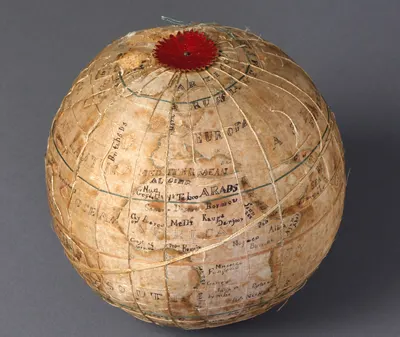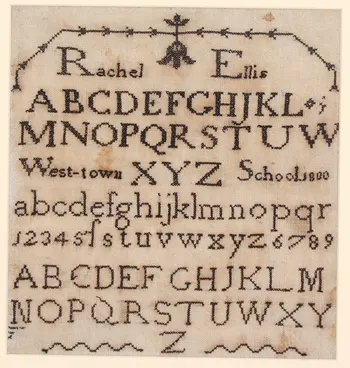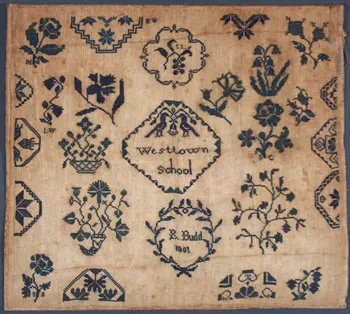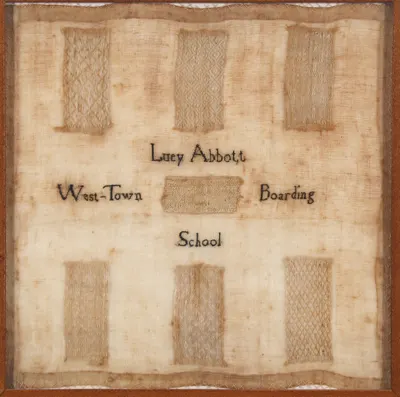- About
- Why ‘Town
- Admission
- Lower School
- Middle School
- Upper School
- Summer Programs
- Academic Calendar
- Athletics
- Arts
- MyWesttown
- Photos
- Support Westtown
- Alums
Samplers made at Westtown School during the early 19th century reflect the educational and religious mission of the school, founded in 1799 by the Philadelphia Yearly Meeting of the Religious Society of Friends.
Philadelphia Quakers opened the school so that their children could have a useful education in a setting wholly in keeping with Quaker practices and the testimonies of plainness and simplicity, peace, integrity and equality. The school’s collection of over 140 flat samplers includes many made by girls in sewing class at Westtown, others stitched by students outside of school and some made by girls not associated with Westtown. Threads of Useful Learning: Westtown School Samplers, authored by Westtown School archivist Mary Uhl Brooks, is a fully-illustrated book examining the school’s needlework collection. Purchase the book online here.
Westtown School has proudly partnered with the Lodestone Collective to offer a special collection of textile products – pillows, tea towels, and other items – inspired by needlework in the school’s Archives. You can find the collection here.

Much of Westtown was modeled on Ackworth School, a Quaker boarding school founded in Yorkshire, England, in 1779. This is evident even in the sewing curriculum. The styles of samplers made at Westtown were influenced by those done at Ackworth, along with needlework from nearby York School for Girls, founded in 1785. The Westtown collection includes two samplers from York School and a sampler made at Ackworth for Rebecca Jones, a Philadelphia Quaker and member of the first Westtown School General Committee, who visited the English schools during four years of ministry in Great Britain from 1784 to 1788.
Both boys and girls were considered scholars at Westtown, and though taught separately, each had classes in reading, writing, mathematics, bookkeeping, geography and the natural sciences.

Boys also learned surveying skills, while girls were offered sewing class. Girls generally spent two weeks out of a six-week period in sewing class practicing their skills in knitting and plain sewing; making bonnets, sewing bags, thread cases and pin cushions, as well as samplers and fabric globes, all the while continuing their other studies. The embroidered silk globes, both terrestrial and celestial, show the importance of geography and astronomy in their studies – and the advanced needlework skills of some of the students.
Sewing remained part of the Westtown curriculum until 1843 when it was discontinued by a decision of the Committee on Instruction. Though no longer a formal part of their education, girls continued to do needlework during their free time at the school for many more years.Marking (or alphabet) samplers were a common style of sampler made by all girls, including those at Westtown. This sampler by Rachel Ellis, one of the first girls to enter Westtown in 1799 (along with her sister Mary), includes a top border common to Ackworth samplers—a cut corner and harebell (of the bellflower family). The very plain, legible style of letters is typical of Quaker samplers.

Rebecca Budd entered Westtown as a student in 1799 at age 20 and was soon promoted to teacher. This sampler stitched by her in 1801 contains monochromatic half medallions, a center cartouche, and floral patterns, all reminiscent of Ackworth samplers. Not all Westtown medallion or spot samplers are monochromatic, and some contain the initials of the maker’s family members or Westtown classmates.
Darning samplers (also made at Ackworth School) were very practical exercises; girls learned to stitch different patterns for mending a variety of weaves of fabric. This one was by Lucy Abbott, age 16, who attended Westtown for six months in 1804.The extract samplers reflect the religious nature of the school.
The verses stitched inside the oval vine are taken from authors whose views on piety, domestic happiness, social reform and everyday spirituality were familiar to Quakers. On all types of Westtown samplers one might find the school name spelled in variant ways (including Weston) which was acceptable until later in the 19th century when the school settled on Westtown, as it is today.
